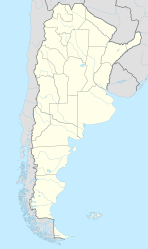Villa General Belgrano
| Villa General Belgrano | |
|---|---|
| Village | |

Aerial view of Villa General Belgrano
|
|
| Location of in Argentina | |
| Coordinates: 31°58′S 64°34′W / 31.967°S 64.567°WCoordinates: 31°58′S 64°34′W / 31.967°S 64.567°W | |
| Country |
|
| Province | Córdoba |
| Department | Calamuchita |
| Elevation | 709 m (2,326 ft) |
| Population | |
| • Total | 5,888 |
| Demonym(s) | Belgranense |
| Time zone | ART (UTC-3) |
| CPA base | X5194 |
| Dialing code | +54 3546 |
Villa General Belgrano, a small mountain village of 6,260 inhabitants is named after the creator of the Argentine flag Manuel Belgrano and located in a lush green valley of Calamuchita in the hills in the Province of Córdoba in central Argentina.
Villa General Belgrano was founded in 1930, by two German speculators attracted by its agricultural potential. The Alpine quality of the village attracted immigrants from Germany, Switzerland, Italy and Austria.
In 1940, after the Battle of the River Plate, German seaman scuttled and sunk their battleship, the Admiral Graf Spee off the coast of the Montevideo harbour, and 130 of its surviving sailors settled in the village along with the original settlers and landscaped the mountain ranges of Córdoba with red-roofed, wood-frame homes, microbreweries and pastry and chocolate shops which gave it that unique style that distinguishes it today. A well-known Geman resident was Kurt Tank, who went to became a leading member of the Argentine Aeronautic Institute.
The village, characterized by its typically Bavarian style architecture, survives on a steady flow of tourists with an appetite for German delicacies like apple strudel, leberwurst and spätzle and beer even if German cuisine recipes are not strictly respected by local restaurants. Oktoberfest here is hailed as the third-most important Oktoberfest site after Munich and Blumenau in Brazil. The village offers an above-average (considering surrounding villages) quality of accommodations to the visitors in hotels and cabins, including a local Howard Johnson's.
...
Wikipedia

